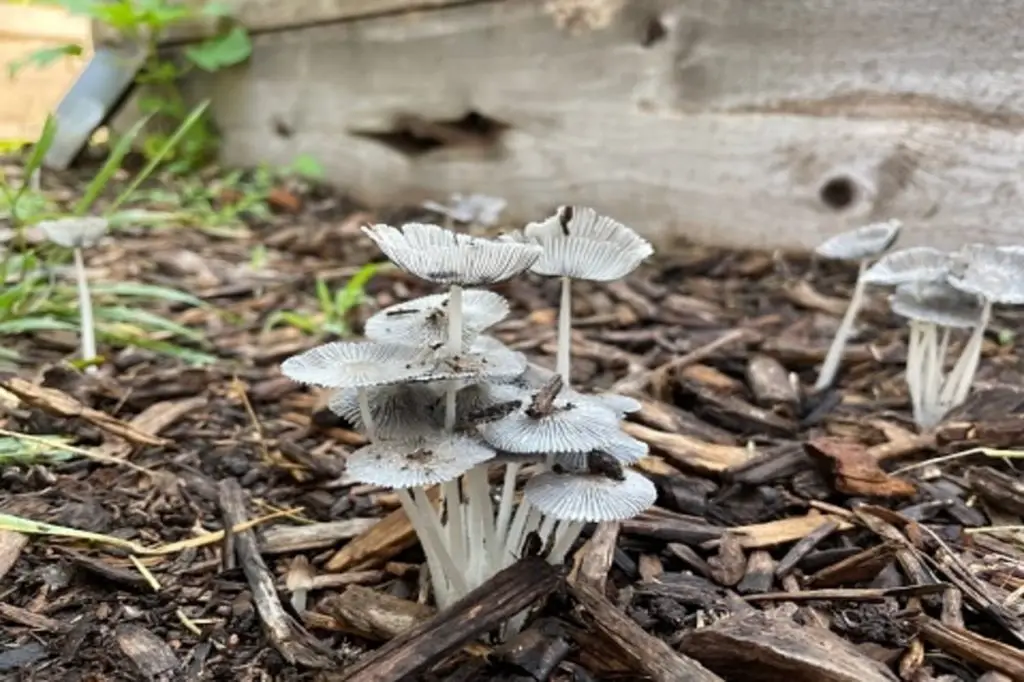So, you’ve got mushrooms popping up in your mulch? This is quite a common issue that gardeners face. If there’s excess moisture retention in the mulch you’ve applied, mushrooms will likely pop up.
If you want to preserve your farm/garden’s aesthetic value and wouldn’t want to risk the mushrooms being poisonous and affecting your plants, then there’s a solution here for you.
Here’s a compiled simple list of how to get rid of mushrooms in mulch regardless of the stage of mushroom infestation on your farm.
Raking up your mulch regularly stops mushrooms from growing in your garden. Vinegar will kill the mushrooms in your mulch. Baking soda is also effective in getting rid of mushrooms from mulch. However, a more effective method is using fungicides.
For further explanations and ‘how to,’ keep reading.
Also Check: How To USe A Living Mulch?
- Will Vinegar Get Rid of Mushrooms in Mulch?
Vinegar will kill mushrooms in mulch. You can use pure white vinegar or mix part vinegar, water, and spray on your mulch. Vinegar works to get rid of mushrooms in mulch due to the acetic acid in the product.
The results from using mushrooms are almost instant. Since it’s cheap and almost readily available to everyone, you can use it whenever you see mushrooms in mulch.
It’s a simple and effective method as you’re likely to have some stocked in the house.
If used well, vinegar gets rid of mushrooms and prevents them from spreading again.
However, while spraying, cover your eyes and nose and sprinkle about 4-6 inches away from the mushrooms.
Remember to spray every six days until the mushrooms are completely dried up.
- Can I Use Baking Soda to Get Rid of Mushrooms in Mulch?
You can use baking soda to get rid of mushrooms in mulch; it’s one of the best methods available.
Baking soda kills mushrooms by causing an imbalance in the pH of the mulch. Mushrooms prefer acidic conditions. Adding baking soda, therefore, disrupts the spread.
While getting started with baking soda as a solution to mushroom removal, mix one tablespoon with a gallon of water. Shake well before spraying.
You’ll need to make several mixtures and spray the mulch thoroughly.
The mixture acts as a natural fungicide, increasing the alkaline levels of the soil, which gets rid of mushrooms in mulch.
- Are Fungicides Effective in Getting Rid of Mushrooms in Mulch?
Yes, you can use fungicides to get rid of mushrooms in mulch. Fungicides work effectively as eradicators since mushrooms are fungi.
You can purchase a fungicide spray from your local agricultural shop. However, something worth noting is that fungicide, while practical, is mainly used to prevent rather than eradicate mushrooms in mulch.
For fungicides that control mushrooms after they develop, it’s advisable to call professionals to apply on your farm. Most preferred are azoxystrobin and flutolanil. However, they’re pretty toxic and may harm your health if you’ve not taken great safety measures.
- How Do I Stop Mushrooms From Growing In My Garden?
You can keep mushrooms from growing in your garden by controlling the temperature and acidity of your mulch at a precise measurement.
Here are more suggestions to help get rid of mushrooms in mulch.
- Keep Your Garden/Farm Clean
The simplest way you can learn how to get rid of mushrooms in mulch is by keeping your farm clean.
By clean, I mean rack and pick the fallen leaves, dead flowers, and animal droppings if you have those and fallen fruit. These are all contributors to increased moisture in your garden, be sure not to let them build up.
The dead fallen plants and animal droppings could also contain fungal spores, which leads to the problem of mushrooms in your mulch and increases the acidity of your mulch. If it’s not addressed, it could mean double trouble for you.
- Constantly Rake The Mulch
Increased moisture causes mushroom infestation in your mulch; therefore, constantly fluffing up works wonders in getting rid of mushrooms in mulch.
Fluffing up mulch doesn’t mean merely turning over mulch mindlessly. You need to get into it.
For proper aeration, use a wide mouth rake and turn mulch over until you have thoroughly mixed. Raking mulch may be dirty work. You may sometimes need to get in there – hands and knees – so I suggest wearing gardening gloves and overalls.
Proper aeration makes sure your mulch doesn’t retain excess water and breaks up the mycelia that may have built up.
Although the raking process doesn’t guarantee stopping the spread of mushrooms in your mulch, it’ll be several weeks before they pop up again.
- Avoid overwatering
Moist areas promote mushroom growth. As you’re trying to get rid of mushrooms in mulch, monitor how and when you water plants.
Mulch has excellent water retention capacities, that’s why you’re using it, but sometimes we may overdo the whole ‘feed your plant’ thing.
Nonetheless, using sprinkler-based watering can increase the surface area you cover while regulating the amount of water you pour.
Nevertheless, be mindful of the materials you’ve used to make your mulch; this will inform the regularity of watering. Regular watering isn’t necessary if you’re using pine or bark wood mulch.
With overwatering, another consideration to make is the type of soil your plants are growing on. Most of us are not expert soil scientists, but I’m sure you’ve at least inquired about your soil to see what you can and can’t plant. The most concern comes with clay-based soil. They retain water well, so only water when necessary.
- Add A New Layer Of Mulch Regularly
Mulch takes years to decompose, and decomposition generates high moisture and heat levels. Long decomposition periods mean your farm is constantly warm.
The lengthy process isn’t ideal if you’re trying to get rid of mushrooms in mulch. Therefore, you need to occasionally replace or add fresh mulch onto your layer.
Keep it at 2-3 inches above the soil with every new layer added. The measurement ensures that the mulch can still work effectively to prevent weeds and retain moisture while not being too thick to cause mushrooms to pop up.
- Consider Compost
Although compost and mulch are regularly confused, they’re pretty different. One significant difference that helps you get rid of mushrooms on your farm is that, unlike mulch placed on top of your soil, compost is mixed into your soil.
Replacing mulch with compost means that, unlike mulch, another layer on your farm, compost is part of the soil, reducing moisture build-up.
Compost also contains broken-down products, meaning it’s less likely to have spores or mycelia and fewer decaying materials for mushrooms to use as food.
However, for best results, it’s advised that you use matured compost; six months is the suggested period for well-cured compost.
- Trim Shrubs And Trees In The Garden
Like other fungus plants, mushrooms prefer to grow under good shade. So, as a precautionary method, always trim the plants growing on your farm.
You should trim strategically so that your crops can still get shade while preventing mushroom growth, though.
I suggest trimming the twigs and branches growing at the bottom of shrubs and trees. Trimming twigs and branches makes sure your plants still get the required shade, your mulch has time to grow, and mushrooms lose the extra shade.
FAQs
- Can I pull mushrooms from mulch to get rid of them?
You can pull the mushrooms manually from your mulch to get rid of them. However, some mushrooms can be poisonous; protective gloves are required.
If your time is limited, you should focus on removing the mushroom caps rather than the whole body. The mushroom caps tend to have more spores.
However, pulling out mushrooms doesn’t get rid of them. You may see fewer of them for a few days after pulling, but the main issues that led to them haven’t been addressed yet. Therefore, they’ll still pop up. Sadly!
- How many days does it take to get rid of mushrooms in mulch?
The number of days it takes to get rid of mushrooms in mulch is dependent on the method used to remove them.
If you have a big farm and choose to use baking soda or vinegar, it’ll take longer since you have to reapply the mixture for days and, at times, weeks, depending on the infestation.
However, for more robust solutions like fungicides, it takes about seven days after application to remove mushrooms in mulch.
It’s advisable to be aware that the faster mushrooms seem to die from a preventative method, the faster they may come back. To avoid this, apply whichever solution you’ve chosen every two weeks for about two months.
Parting Point
Mushrooms are a nuisance, but sometimes, you may have slow-growing mushrooms that don’t threaten your crops or farm. Take your time to find the king of mushrooms popping up in your mulch.
If you have an infestation, though, these simple processes discussed here are sure ways to help you get rid of mushrooms in mulch. For long-lasting results, use fungicides, and be sure to rake your mulch often.
Take precautionary measures when engaging in any of these processes. There are toxic chemicals in most of these products, so wear gloves and masks to protect yourself.


